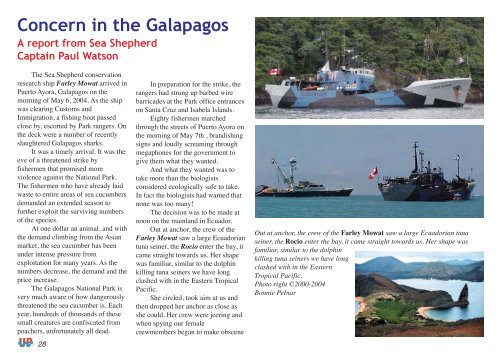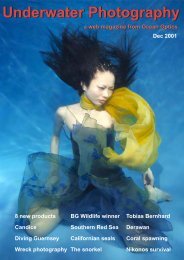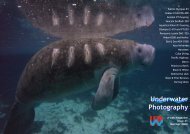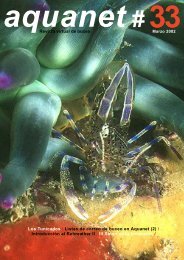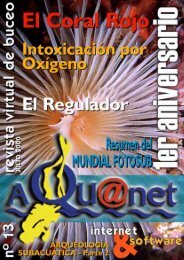Underwater Photography - SENSACIONES.org
Underwater Photography - SENSACIONES.org
Underwater Photography - SENSACIONES.org
Create successful ePaper yourself
Turn your PDF publications into a flip-book with our unique Google optimized e-Paper software.
Concern in the Galapagos<br />
A report from Sea Shepherd<br />
Captain Paul Watson<br />
The Sea Shepherd conservation<br />
research ship Farley Mowat arrived in<br />
Puerto Ayora, Galapagos on the<br />
morning of May 6, 2004. As the ship<br />
was clearing Customs and<br />
Immigration, a fishing boat passed<br />
close by, escorted by Park rangers. On<br />
the deck were a number of recently<br />
slaughtered Galapagos sharks.<br />
It was a timely arrival. It was the<br />
eve of a threatened strike by<br />
fishermen that promised more<br />
violence against the National Park.<br />
The fishermen who have already laid<br />
waste to entire areas of sea cucumbers<br />
demanded an extended season to<br />
further exploit the surviving numbers<br />
of the species.<br />
At one dollar an animal, and with<br />
the demand climbing from the Asian<br />
market, the sea cucumber has been<br />
under intense pressure from<br />
exploitation for many years. As the<br />
numbers decrease, the demand and the<br />
price increase.<br />
The Galapagos National Park is<br />
very much aware of how dangerously<br />
threatened the sea cucumber is. Each<br />
year, hundreds of thousands of these<br />
small creatures are confiscated from<br />
poachers, unfortunately all dead.<br />
28<br />
In preparation for the strike, the<br />
rangers had strung up barbed wire<br />
barricades at the Park office entrances<br />
on Santa Cruz and Isabela Islands.<br />
Eighty fishermen marched<br />
through the streets of Puerto Ayora on<br />
the morning of May 7th , brandishing<br />
signs and loudly screaming through<br />
megaphones for the government to<br />
give them what they wanted.<br />
And what they wanted was to<br />
take more than the biologists<br />
considered ecologically safe to take.<br />
In fact the biologists had warned that<br />
none was too many!<br />
The decision was to be made at<br />
noon on the mainland in Ecuador.<br />
Out at anchor, the crew of the<br />
Farley Mowat saw a large Ecuadorian<br />
tuna seiner, the Rocio enter the bay, it<br />
came straight towards us. Her shape<br />
was familiar, similar to the dolphin<br />
killing tuna seiners we have long<br />
clashed with in the Eastern Tropical<br />
Pacific.<br />
She circled, took aim at us and<br />
then dropped her anchor as close as<br />
she could. Her crew were jeering and<br />
when spying our female<br />
crewmembers began to make obscene<br />
Out at anchor, the crew of the Farley Mowat saw a large Ecuadorian tuna<br />
seiner, the Rocio enter the bay, it came straight towards us. Her shape was<br />
familiar, similar to the dolphin<br />
killing tuna seiners we have long<br />
clashed with in the Eastern<br />
Tropical Pacific.<br />
Photo right ©2000-2004<br />
Bonnie Pelnar


